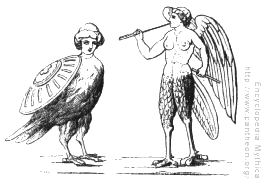It's a Bird, It's a Plane, It's….What is a harpy?by
Rebekah
 Recently,
there has been speculation as to what certain figures seen flying through the
air could be. Some have speculated that they are birds, but this idea was abandoned
when someone got a closer view. Some speculated that they were planes, but then
everyone realized that we do not know what a plane is either. Finally, it was
determined that these mysterious beings are harpies.
Recently,
there has been speculation as to what certain figures seen flying through the
air could be. Some have speculated that they are birds, but this idea was abandoned
when someone got a closer view. Some speculated that they were planes, but then
everyone realized that we do not know what a plane is either. Finally, it was
determined that these mysterious beings are harpies.
What are
They?These harpies or "Harpyiai (theoi.com)" are quite
unusual and frightful beings. They are either described as winged women with,"
beautiful hair and feathers on their shoulders but with crooked claws (archaeonia.com),"
or as having a female upper body with the body and legs of a bird. Bulfinch described
them as being, "disgusting birds with the heads of maidens, with long claws
and faces pale with hunger." Their name, Harpy, even means snatchers or robbers
(Archaeonia.com). They no doubt strike fear in all who encounter them.
We are
not certain as to how many harpies there actually are. We are certain that there
are at least two, but possibly as many as four harpies. There was even an account
of a flock of them (Bulfinch), but this does not include a specific number. It
is certain that there are two named Aello (which means Stormwind) and Okypete
(or Ocypete; which means Swiftwind). There are possibly (likely) two more harpies,
Kelaino (or Celaeno; which means Dark) and Podarge (which means Fleet-Foot).
Also,
the harpy Podarge has been rumored to have given birth by Zephyr (the West Wind)
to Xanthus and Balius, Achilles beautiful stallions (Occultopedia.com). It is
also possible that she is the mother of Dioskouros' steeds Flogeus and Arpagus
(Archaeonia.com). We are not sure why these bird-women would give birth to horses,
but they are equated with "action, perpetual movement and speed (Archaeonia.com)."
Origin of the Harpies
It is also not certain where
they came from. They are possibly the offspring of Poseidon (god of the sea and
earthquakes), Typhoeas (a half-human a half-reptile giant with one hundred dragon
heads), Thaumas (sea-god) and Electra, or Thaumas and Ozomene. There is more evidence
that they are the children of Thaumas and Electra. For example, Apollodorus 1.10
says that, "Thaumas and Elektra has Iris and the Harpyiai named Aello and
Okypete (theoi.com)." Also, the Hyginus Preface says, "From Thaumas
and Electra: Iris, Harpyiae Celaeno, Ocypete, Podarce (theoi.com). This indicates
that the most likely parents of the harpies are Thaumas and Electra. Strangely,
it has been suggested that they are the sisters of Iris (personification of the
rainbow; wife of Zephyr) (Archaeonia.com). This is strange because Iris is not
seen as evil, while the harpies are. Also, it is Iris' husband who is the suggested
father of Podarge's children.
Their purpose is one thing that has been determined.
It has been agreed that they are servants of Hades. They are sent to bring more
souls to Tartarous. They were also sent by the gods to torment Phineus. When Phineus,
who was blinded by Zeus (or Jupiter) for his cruelty, had received a meal, the
harpies would come down and snatch his food. Two of the Argonauts, Zetes and Calais,
who were known as the Boreads, drove them away to an island where Aeneas found
them (Bulfinch's). These islands are known as the Plotes Islands or Stophades.
The harpies then hid in a cave in Crete (Archaeonia.com).
The harpies also harmed
the daughters of King Pandareos. His daughters were favored by Aphrodite. When
she left them alone, the harpies snatched them and gave them to the Erinyes (Fates)
(ARchaeonia.com).
These vile creatures are also associated with storms, wind,
and ghosts. This includes hurricanes. It is believed that when a person is lost
at sea, it is the fault of the harpies. They are considered to be goddesses of
wind and death spirits (Archaeonia.com).
These harpies are frightful beasts.
If you see a harpy approaching, it is certain you will be carried away. If it
were not for the Boreads, we might still have them to fear. However, since they
have been driven away, we should be safe for now.
Works CitedThe
Harpies. 16 March 2004. <http://www.archaeonia.com/religion/deities/harpies.htm>.
The
Harpies. Bulfinch's Mythology. 13 March 2004. <http://www.bulfinch.org/fables/bull31.html>.
Harpy.
Occultopedia. 16 March 2004. <http://www.occultopedia.com/h/harpy.htm.>
The
Harpyiai. 20 March 2004. <http://www.theoi.com/Pontos/Harpyiai.html.>
Harris,
Stephen L. and Platzner, Gloria. ed. Classical Mythology: Images & Insights
3rd ed. London: Mayfield Publishing Company, 2001.
Return to the index
 Recently,
there has been speculation as to what certain figures seen flying through the
air could be. Some have speculated that they are birds, but this idea was abandoned
when someone got a closer view. Some speculated that they were planes, but then
everyone realized that we do not know what a plane is either. Finally, it was
determined that these mysterious beings are harpies.
Recently,
there has been speculation as to what certain figures seen flying through the
air could be. Some have speculated that they are birds, but this idea was abandoned
when someone got a closer view. Some speculated that they were planes, but then
everyone realized that we do not know what a plane is either. Finally, it was
determined that these mysterious beings are harpies.